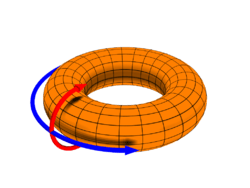Safety factor (plasma physics)

 ) direction, represented by the red arrow, and the toroidal (
) direction, represented by the red arrow, and the toroidal ( or
or  ) direction, represented by the blue arrow. The major axis, R, is measured from the center of the hole in the middle to the center of the cylindrical confinement area. The minor axis, r, is the radius of the cylinder.
) direction, represented by the blue arrow. The major axis, R, is measured from the center of the hole in the middle to the center of the cylindrical confinement area. The minor axis, r, is the radius of the cylinder.In a toroidal fusion power reactor, the magnetic fields confining the plasma are formed in a helical shape, winding around the interior of the reactor. The safety factor, labeled q or q(r), is the ratio of the times a particular magnetic field line travels around a toroidal confinement area's "long way" (toroidally) to the "short way" (poloidally).
The term "safety" refers to the resulting stability of the plasma; plasmas that rotate around the torus poloidally about the same number of times as toroidally are inherently less susceptible to certain instabilities. The term is most commonly used when referring to tokamak devices. Although the same considerations apply in stellarators, by convention the inverse value is used, the rotational transform, or i.
Background
The key concept in magnetic confinement fusion is that ions and electrons in a plasma will rotate around magnetic lines of force. A simple way to confine a plasma would be to use a solenoid, a series of circular magnets mounted along a cylinder that generate a uniform lines of force running down the long axis of the cylinder. A plasma generated in the center of the cylinder would be confined to run along the lines down the inside of the tube, keeping it away from the walls. However, it would be free to move along the axis and out the ends of the cylinder.
An obvious solution to this problem is to bend the solenoid around into a circle, forming a torus (a ring or donut). In this case the particles will still be confined to the middle of the cylinder, and even if they move along it they would never exit the ends - they would circle the apparatus endlessly. However, Fermi noted a problem with this arrangement; consider a series of circular magnets with the toroidal confinement area threaded through their centers, the magnets will be closer together on the inside of the ring, with a stronger field. Particles in such a system will drift up or down across the torus.[1]
The solution to this problem is to add a secondary magnetic field at right angles to the first. The two magnetic fields will mix to produce a new combined field that is helical, like the stripes on a barber pole. A particle orbiting such a field line will find itself near the outside of the confinement area at some times, and near the inside at others. Although a test particle would always be drifting up (or down) compared to the field, since the field is rotating, that drift will, compared to the confinement chamber, be up or down, in or out, depending on its location along the cylinder. This effect greatly reduces the overall drift.[2]
Rotational transform
The effect of the helical field is to bend the path of a particle so it describes a loop around the cross section of the containment cylinder. At any given point in its orbit around the long axis of the toroid, the particle will be moving at an angle, θ.
In the simple case, when the particle has completed one orbit of the reactor's major axis and returned to its original location, the fields will have made it complete one orbit of the minor axis as well. In this case the rotational transform is 1.
In the more typical case, the fields do not "line up" this way, and the particle will not return to exactly the same location. In this case the rotational transform is calculated thus:

where R is the major radius,  the minor radius,
the minor radius,  the poloidal field strength, and
the poloidal field strength, and  the toroidal field. As the fields typically vary with their location within the cylinder,
the toroidal field. As the fields typically vary with their location within the cylinder,  varies with location on the minor radius, and is expressed i(r).
varies with location on the minor radius, and is expressed i(r).
Safety factor
In the case of an axisymmetric system, which was common in earlier fusion devices, it is more common to use the safety factor, which is simply the inverse of the rotational transform:

The safety factor is essentially a measure of the "windiness" of the magnetic fields in a reactor. If the lines are not closed, the safety factor can be expressed as the pitch of the field:

As the fields vary across the minor axis, q also varies and is often expressed as q(r). On the inside of the cylinder on a typical tokamak it converges on 1, while at the outside it is nearer 6 to 8.
See also
- Troyon limit
Notes
References
- Jeffrey Freidberg, "Plasma Physics and Fusion Energy", Cambridge University Press, 2007